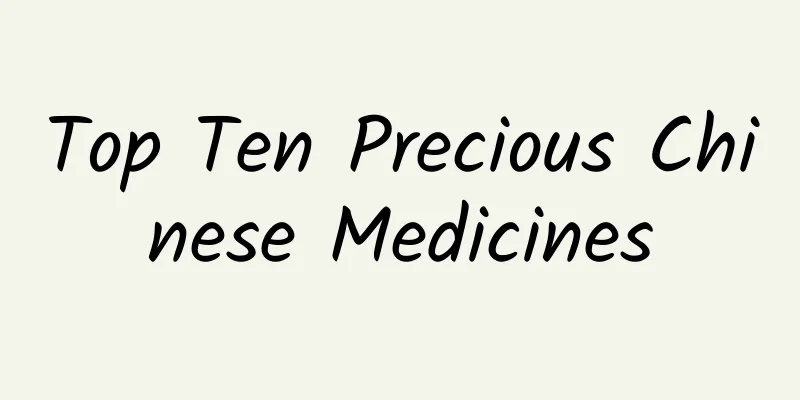Top Ten Precious Chinese Medicines

|
Chinese herbal medicine is what we call traditional Chinese medicine, which is in contrast to Western medicine. Chinese medicinal materials mainly originated in my country. In addition to herbal medicines, animal medicines such as snake gall, deer antler slices, shells such as pearls and clam shells, and minerals such as dragon bones and magnets are all Chinese medicinal materials used to treat diseases. For many reasons, many Chinese medicinal materials are scarce and precious. Wild Lingzhi According to the first Chinese book on therapeutic medicine, Shennong's Herbal Classic, there are six types of wild Ganoderma lucidum: purple, red, green, yellow, white and black. Poria has a sweet and mild effect. Since ancient times, wild Ganoderma lucidum has been regarded as a symbol of good luck, wealth, happiness and longevity. It is known as "immortal grass" and "auspicious grass". Chinese traditional medicine has always regarded it as a precious Chinese herbal medicine for nourishing health, strengthening the body, and nourishing blood. Wild Ginseng Wild ginseng is one of the specialties of Northeast China. It is called wild ginseng because its root is thick, spindle-shaped, and often forked. The overall view resembles a human head, hands, feet, and limbs. In ancient times, ginseng was elegantly called Morinda officinalis, earth spirit, and magic grass. Wild ginseng is known as the "king of herbs" and is one of the world-famous "Three Treasures of Northeast China" (wild ginseng, sable fur, and deer antler slices). It is a precious Chinese medicinal material that is well-known both at home and abroad and trusted by people of all ages. In the history of Chinese medicine, the application of wild ginseng has a very long history. Ambergris It refers to the dried product of the intestinal secretions of the sperm whale, a small animal of the sperm whale family. It comes from the intestinal secretions of slaughtered sperm whales (i.e. dolphin excrement, which is the black-gray crystalline feces metabolized from the digestive tract after the sperm whale swallows the cuttlefish). This species is the most precious Chinese medicinal material among the feces of various small animals and is extremely rare and valuable. From ancient times to the present, ambergris has been used as a high-end spice. It is relatively expensive, almost as expensive as gold. "Compendium of Materia Medica" records that ambergris can "promote blood circulation, remove blood stasis, benefit essence, assist yang pathways, and promote blood circulation." Ambergris is a precious traditional Chinese medicine used for medical treatment and tonic. Cordyceps Cordyceps, also known as Cordyceps sinensis and Cordyceps sinensis, is a bacterial Cordyceps of the ergot family. It is a complex of the fruiting body and larvae remains that parasitizes on the larvae of insects in the genus Lycopodiidae. Cordyceps is a traditional precious nourishing Chinese herbal medicine, and is listed as one of the three major health-preserving ingredients along with natural ginseng and deer antler slices. It has mild medicinal effects and can be eaten all year round. It is suitable for the old, young, sick, weak and deficient. It has more extensive effects and functions than other types of health-preserving foods. Meigui In addition to the Tibet Autonomous Region, snow lotus is also distributed in Xinjiang, Qinghai, Sichuan and Yunnan provinces in China. Folk customs all over the country use snow lotus wolf grass as medicine, which is mainly used to treat snow blindness, toothache, rheumatoid arthritis, erectile dysfunction, irregular menstruation, menorrhagia, and secretions. Indonesian folk customs also use snow lotus to treat patients with many special diseases. Such as gastric ulcer, hemorrhoids, bronchitis, heart disease, nose bleeding and snake bites. Snow lotus has a long history of being used as a therapeutic drug in Tibetan medicine. Polygonum multiflorum Shouwu is the dried tuber of the Polygonum multiflorum plant Shouwu of the Polygonaceae family, and its vine is called "night-crossing vine". Li Ao, a Tang Dynasty scholar, once wrote "The Biography of Polygonum multiflorum". It was originally a person's name. In the "Compendium of Materia Medica", the original "Yejiaoteng" was renamed "Shouwu". It is said that Shouwu was discovered by He Tianer, a native of Nanhe County, Shunzhou in 813. He lived to be 160 years old after taking it for a long time. Shouwu has the effects of tonifying deficiency, benefiting kidney blood, blackening temples, stopping hair loss and promoting hair growth, and strengthening tendons and bones. It is a precious Chinese herbal medicine. Medical books say that Shouwu and dried Shouwu both refer to raw Shouwu. The original Chinese medicinal materials are removed of residues, cleaned and moistened thoroughly, cut into slices and dried before being used as medicine. It focuses on moistening bowels and intestines, reducing lipids and removing toxins. Deer antler slices When the tender antlers of male deer have not grown hard bones, they are covered with hair and contain blood, and are called antler slices. It is a precious Chinese medicinal material. As a nourishing and strengthening tonic, it is effective for weakness, neurasthenia, etc. This product is a commonly used Chinese medicine and is listed as a medium-grade medicine in "Shennong's Herbal Classic". There are many types and specifications on the market. Due to the different original animals, they are divided into two types: flower antler slices and red deer antler; due to different harvesting methods, they are divided into chopped antler and sawed antler. Dragon's Blood Dracaena draco is a precious Chinese medicinal material that is native to my country. It is a high-grade spice. If you put a little bit in the room, it will make the room fragrant and the taste is completely different. Dragon's blood not only has a pleasant fragrance, but also has a long-lasting aroma. Dracaena draconis is the secretion of the glandular sac between the navel and sexual organs of male musk deer. After drying, it is in granules or small pieces with a unique fragrance and bitter taste. It can be made into spices and can also be used as medicine. It is a central nervous system stimulant and can relieve pain and reduce swelling when applied externally. Commonly known as "musk". It is listed as a fine product in "Shennong's Herbal Classic". Familia The Familia is famous for its head which resembles a horse's head. It is a unique and precious small and medium-sized freshwater fish that lives near land and shallow waters. It belongs to the genus Familia in the family Syngnathidae in the order Syngnathidae. Fumeilai is a precious traditional Chinese medicine with high economic value. It has the medicinal value functions of strengthening physical fitness, strengthening yang and tonifying kidney, relaxing muscles and activating blood circulation, relieving inflammation and pain, calming nerves and promoting sleep, relieving cough and relieving asthma, etc. It is especially effective in treating diseases of the central nervous system. It has been deeply favored by people since ancient times, and men also love it very much. Therefore, there is a huge demand for Fumilai in the global sales markets. Bird's Nest Bird's nests are the caves of the seabird swiftlet. Most of them are located on cliffs of islands with subtropical and subtropical climates, closely surrounded by blue sky, white clouds and clear water. When the swiftlet starts to build its nest in spring, a kind of collagen fiber saliva is metabolized in its mouth. After being spit out and dried by the sea breeze, it becomes a transparent and slightly yellowish substance, which is the main component of the bird's nest. The swiftlet uses this saliva with fine algae, down feathers on its body and soft fiber materials to make a nest, which is what we often call "bird's nest". Bird's nest is a precious delicacy and also a valuable Chinese medicinal material. It has the effect of moistening the lungs and nourishing yin, and is mainly used to treat symptoms such as consumptive cough and hemoptysis. It is produced in Indonesia, the Malay Archipelago, Hainan Island and the South China Sea Islands in my country. |
<<: Side effects and contraindications of costusroot
>>: The effect of drinking water soaked with Adenophora
Recommend
Super-large sunspots return, will geomagnetic storms and auroras appear again?
Produced by: Science Popularization China Author:...
What happens to your body if you eat 1 bowl of rice noodles every day? Eating this way is healthier →
Rice noodles are a very popular delicacy in south...
The efficacy and function of the herb
Although Western medicine and Western drugs are m...
The efficacy and function of betel nut flower
Speaking of betel nut flower, I believe many frie...
What are the functions of plantain
Plantain is a perennial herb with great medicinal...
Why is the upcoming Year of the Tiger only 355 days?
The upcoming Lunar Year of the Tiger From Februar...
Is eating animal organs harmful to health? Can you eat them safely? Today I will tell you the truth...
This article was reviewed by Pa Li Ze, chief phys...
NRF: 2024 Back-to-School Shopping Season Survey
As of early July, more than half of back-to-schoo...
The efficacy and function of Scrophularia
Speaking of common medicines, there are many. Fro...
From mid-to-late stage lung cancer to successful anti-cancer treatment, this doctor has been actively fighting cancer for 9 years and summed up these 6 points
Many people are afraid of cancer and think that i...
The efficacy and function of Ipomoea aquatica[picture]
Speaking of Ipomoea aquatica [picture], many peop...
What are the benefits of soaking your feet regularly?
As soon as winter comes, "foot soaking"...
Three-legged frogs? There are plenty!
In the mid-1990s, a child at New Country School i...
What are the effects and functions of horse urine?
Sambucus nigra, also known as elderberry, is a ve...
Introduction to Common Chinese Medicinal Materials
Traditional Chinese medicine is accumulated slowl...









